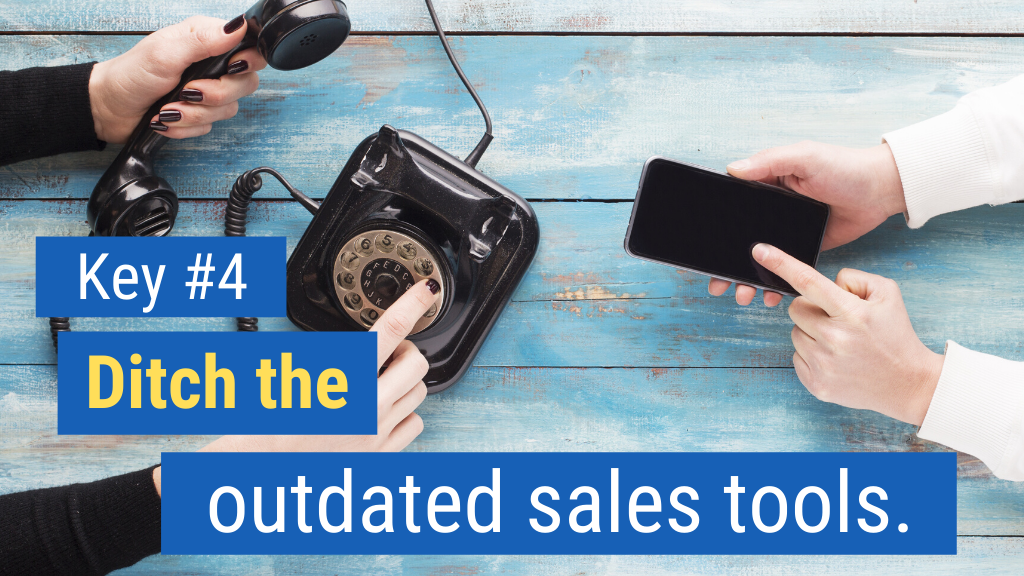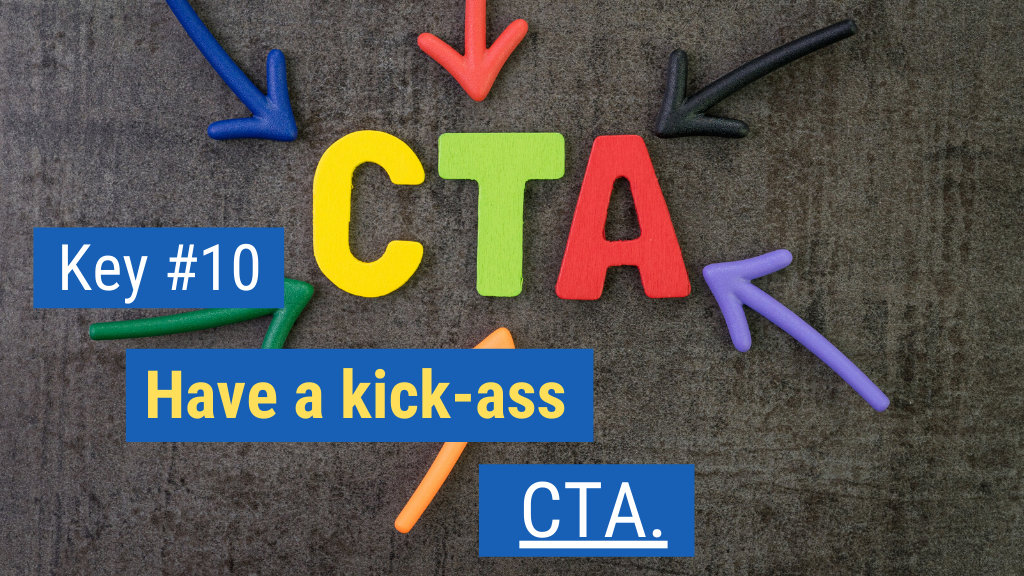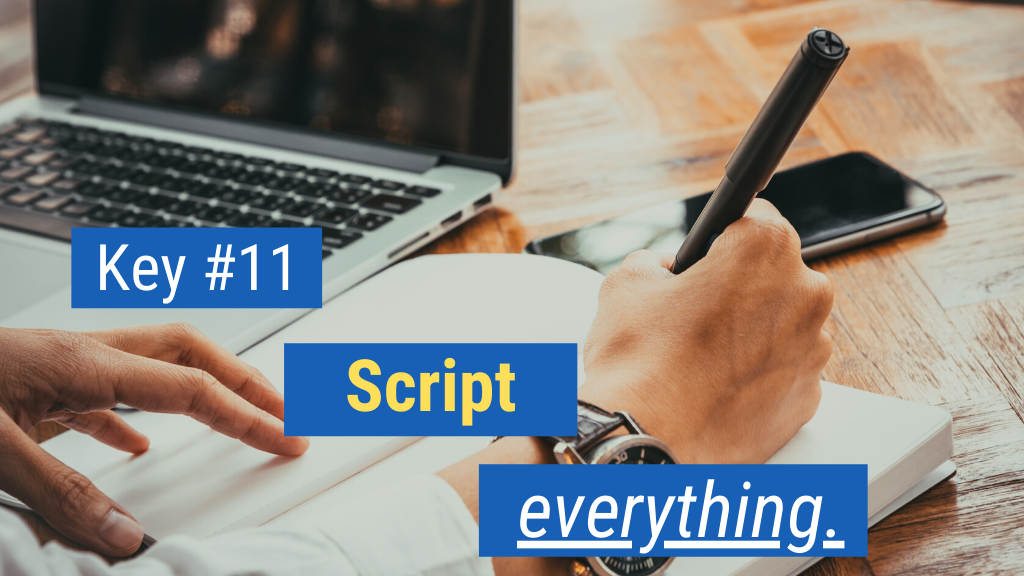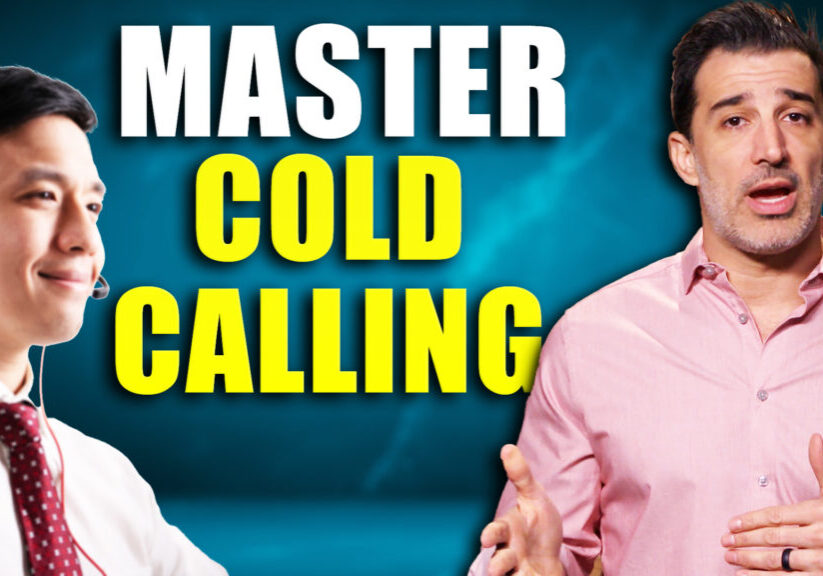Do you ever look at your calendar and realize that you just don’t have enough appointments?
Or do you feel like you need to close every single opportunity that comes your way, because you have so few in your pipeline to begin with?
Do you find yourself willing to hop on calls with prospects that you know are complete tire-kickers—but you do it anyway because you feel like you can’t pass up the hint of an opportunity?
Or maybe you’re able to set some high-quality sales meetings, but you need a better way to consistently generate more appointments in order to ultimately improve your sales number.
If any of these scenarios sound familiar to you, the real problem is that you’re stuck in the old-school approach to generating sales leads.
And chances are, you’re doing what I call “hope prospecting” instead of using a systematic process for finding prospects.
It’s time to change your approach to generating sales leads if you want to set more meetings. In this video, I’m going to walk you through the 14 keys to generating more high-quality sales meetings, while kicking the old-school lead gen approach to the curb. Check it out:

Set More Sales Meetings Key #1: Know exactly how many appointments you need.
 If you’re stuck in the old-school approach to generating sales meetings, you likely have no idea how many appointments you actually need to set in order to hit your sales goals. Think about it: Do you know, off the top of your head, exactly how many appointments you need to set every single week in order to hit your sales numbers?
If you’re stuck in the old-school approach to generating sales meetings, you likely have no idea how many appointments you actually need to set in order to hit your sales goals. Think about it: Do you know, off the top of your head, exactly how many appointments you need to set every single week in order to hit your sales numbers?
If you don’t have the answer, then you’re starting from a place of complete uncertainty. Without clarity on the number of sales meetings you need to set, nothing else you do will enable you to successfully hit your goals. It’s as simple as that.
That’s why one of the biggest keys to successful prospecting is actually knowing that magic number of appointments you need—and then you can work backward from there. Keep reading until the end to learn exactly how to determine your magic number.
Key #2: Have a process.
 Another hallmark of the old-school approach to setting sales meetings is haphazard prospecting. Most salespeople don’t have any real structure around their prospecting activities, so they randomly make cold calls, send emails, and do LinkedIn outreach without any clear framework holding everything together.
Another hallmark of the old-school approach to setting sales meetings is haphazard prospecting. Most salespeople don’t have any real structure around their prospecting activities, so they randomly make cold calls, send emails, and do LinkedIn outreach without any clear framework holding everything together.
This is all about lacking process. If you really want to set more high-quality sales meetings, you need to have a process in place for prospecting that actually works—and makes it so that prospects know who you are before they actually talk to you. And you need to stick to that process. We’ll dive into what that process should look like a bit later on in this article.
Key #3: Use a script.
 Salespeople who are stuck in the old-school approach to generating sales leads rarely, if ever, use a script. This is a huge mistake. In order to set more sales meetings, you need to be scripting everything—your phone calls, your emails, and every single other interaction you have with a prospect. You simply cannot be winging any part of the process. Everything needs to be mapped out ahead of time. More on this later.
Salespeople who are stuck in the old-school approach to generating sales leads rarely, if ever, use a script. This is a huge mistake. In order to set more sales meetings, you need to be scripting everything—your phone calls, your emails, and every single other interaction you have with a prospect. You simply cannot be winging any part of the process. Everything needs to be mapped out ahead of time. More on this later.
Key #4: Ditch the outdated sales tools.
 The next common component of the old-school model is the use of outdated sales tools. The world of prospecting has changed completely in the past couple of years alone. Tools you were using in, say, 2012, might have worked well then, but there’s no way they’re still going to be effective today. Even tools you were using in 2018 are likely to be outdated now. We’ll dive into some updated sales tools in a bit, but for now, just remember this: You need to update your arsenal of sales tools on a regular basis to generate more sales meetings.
The next common component of the old-school model is the use of outdated sales tools. The world of prospecting has changed completely in the past couple of years alone. Tools you were using in, say, 2012, might have worked well then, but there’s no way they’re still going to be effective today. Even tools you were using in 2018 are likely to be outdated now. We’ll dive into some updated sales tools in a bit, but for now, just remember this: You need to update your arsenal of sales tools on a regular basis to generate more sales meetings.
Key #5: Don’t “spray and pray.”
 Old-school lead generation relies on what I like to call “spray and pray,” where salespeople cast a really wide net to reach out to thousands of people at once—hoping something sticks. This frequently includes the use of Constant Contact or another system to send out blast emails. They spray out their message without any real target, and then just pray it finds the right people.
Old-school lead generation relies on what I like to call “spray and pray,” where salespeople cast a really wide net to reach out to thousands of people at once—hoping something sticks. This frequently includes the use of Constant Contact or another system to send out blast emails. They spray out their message without any real target, and then just pray it finds the right people.
This misguided approach will only ever accomplish two things: 1) you won’t generate any high-quality sales meetings, and 2) you’re going to piss a lot of people off. You’ve probably received tons of boilerplate spray-and-pray emails before—don’t they get on your nerves?
Key #6: Use a prospecting blueprint.
 A prospecting blueprint is the opposite of haphazard prospecting. Your blueprint should map out exactly what you’re going to do to generate more sales meetings, every single step of the way.
A prospecting blueprint is the opposite of haphazard prospecting. Your blueprint should map out exactly what you’re going to do to generate more sales meetings, every single step of the way.
This doesn’t require you to spend hours and hours mapping out a process, but it does require you to put some real thought into what your process looks like. That way, you’ll know exactly what you need to do over the next 45 or 60 days in order to bring each prospect through the entire process.
Think about the following considerations: How are you going to be “touching” each prospect? What is your script going to look like for each touch? Are you going to call, email, leave voicemails, send a LinkedIn message, send a package, and follow up on calls—or is there something else you want to do, too? What does that whole process look like?
No more haphazard prospecting. Every single step of the prospecting process should be mapped out in your prospecting blueprint. Ultimately, this seemingly simple exercise will hold the key to helping you generate more high-quality sales meetings than ever before.
Key #7: Know your IPP.

The next pillar of a successful lead generation strategy is understanding and knowing your IPP. Your IPP simply stands for your ideal prospect profile. Who is your ideal prospect? One of the things that we see over and over again is that most salespeople are prospecting to tons of people. But if you’re not sure about who your ideal prospect is, then it’s impossible to correctly target the right people for prospecting. That’s why it’s imperative to think about your IPP up front, so you don’t end up all over the map with prospects who don’t turn into ideal clients.
Be very specific about who your ideal prospect is. And just as important, be specific about who your ideal prospect is not. By knowing who doesn’t fit into your ideal prospect profile, you can get even clearer about who you actually should be spending your time selling to. This is critical to setting more high-quality sales meetings.
Key #8: Make multiple touches to each prospect.
 Remember earlier, when we talked about how your prospecting blueprint should map out all of the “touches” you’ll make to each prospect? Let’s dig into that a bit more. You want to be making around 18–20 touches to each prospect, utilizing a bunch of different channels of outreach throughout the prospecting process (calls, emails, voicemails, LinkedIn connections, FedEx packages, etc.).
Remember earlier, when we talked about how your prospecting blueprint should map out all of the “touches” you’ll make to each prospect? Let’s dig into that a bit more. You want to be making around 18–20 touches to each prospect, utilizing a bunch of different channels of outreach throughout the prospecting process (calls, emails, voicemails, LinkedIn connections, FedEx packages, etc.).
The data shows that a typical prospect isn’t willing to connect with a salesperson until about 18 attempts have been made to contact them. The problem is, most salespeople give up long before they hit the 18-touch mark. They simply don’t hang in there for long enough. If you don’t have lots of touches built into your prospecting blueprint, then you’re in trouble. Be strategic about what types of outreach you do, in what order, and vary it up so you’re not leaning too heavily on one channel of outreach. This is essential to generating more sales meetings.
Key #9: Leverage all of your tools.
 This brings us to the next component of a successful lead generation approach, which is the utilization of lots of different sales tools. Simply put, you need to leverage all of your tools if you’re going to be successful at generating more sales meetings with your ideal prospects.
This brings us to the next component of a successful lead generation approach, which is the utilization of lots of different sales tools. Simply put, you need to leverage all of your tools if you’re going to be successful at generating more sales meetings with your ideal prospects.
We’re alive during an amazing time for sales technology—there are so many tools out there nowadays, it can feel overwhelming. Salespeople have more options than ever when it comes to sales tools they can use to generate more high-quality meetings for more opportunities.
Now, I’m not saying that you need to be using 20 different tools at once, but you do need to be leveraging several cutting-edge sales tools for important areas such as email automation and getting the most out of platforms like LinkedIn. These tools will help you hold your prospecting campaign together, and they will be the secret ingredient that enables your prospecting blueprint to really function at scale.
Ultimately, the biggest asset you have is your time. If you’re not using your time valuably, or you’re not protecting your time, then all of this is going to be for naught. You’re going to be super inefficient, and you’re not going to generate a lot more sales meetings. And let’s not forget, once you actually generate the appointments, then you actually have to sell. So you need to have the process for generating those appointments dialed in with your tools so you’re not wasting any time.
Key #10: Have a kick-ass CTA.
 Your kick-ass CTA (call to action) is what will get prospects to say, “Yeah, I’ll hop on the phone with this salesperson.” At the end of the day, everyone knows that when they respond to a salesperson, they’re signaling that they’re willing to be “sold.” And no one enjoys that experience. So in order to compel prospects to want to talk to you, you’re going to have to use some bait that really speaks to them. This is your kick-ass CTA.
Your kick-ass CTA (call to action) is what will get prospects to say, “Yeah, I’ll hop on the phone with this salesperson.” At the end of the day, everyone knows that when they respond to a salesperson, they’re signaling that they’re willing to be “sold.” And no one enjoys that experience. So in order to compel prospects to want to talk to you, you’re going to have to use some bait that really speaks to them. This is your kick-ass CTA.
What is your powerful CTA that makes prospects willing to talk to you? It can’t be something weak like, “Hey, I’d love to learn more about your business, so that way we can talk about how I can help you.” None of that crap. It never works.
Instead, what you need is a CTA that’s truly enticing and brings value to the prospect’s life. Figure out what will make your ideal prospects say, “Actually, maybe this person could help me finally solve the challenge I’m dealing with.”
Of course, even a blind squirrel can find an acorn every once in a while. But a kick-ass CTA will make it so that your appeal to prospects is almost irresistible. This is what will make all the difference when it comes to setting more sales meetings.
Key #11: Script everything.
 We touched upon this briefly earlier, but let’s explore scripting a little further. You need to be scripting everything out if you want to set more sales meetings. Every interaction that you have with a prospect should be completely scripted out. No guessing. No wondering what to say. Only following the script.
We touched upon this briefly earlier, but let’s explore scripting a little further. You need to be scripting everything out if you want to set more sales meetings. Every interaction that you have with a prospect should be completely scripted out. No guessing. No wondering what to say. Only following the script.
This doesn’t mean that there’s not a bit of art to having great sales conversations. You can’t just read from a script and fail to adapt to what the prospect is saying in the moment. There’s an art to that. But the science behind scripting is what gives you the strong foundation that enables you to make little departures from the script and adapt to the conversation as it flows—without losing your place or scrambling to think of what to say next.
You should have a script prepared for phone calls, emails, LinkedIn outreach, and any other component of your sales process. Salespeople always complain to me, “But Marc, if I use a script, I’m going to sound scripted on my calls.” This is just not true. If you sound scripted, then you’re bad at using your script. Just think about the actors in great movies and TV shows. They all use scripts. Do they sound scripted? Not if they’re any good at what they do! The same goes for salespeople. Follow the script.
Top sales performers are always following some kind of a script when they’re on the phone with prospects. If you’re just getting on the phone and continuously thinking, “What am I going to say next?” then you’re doing it all wrong. Having a script means you can always leverage your best lines, give the best insight you possibly can, and keep the conversation tight and on topic. Having that script is absolutely critical to generating more sales meetings for that reason.
(By the way, if you disagree with me on this, then that’s fine. Don’t feel like you have to read any more. But if you’re serious about taking your sales to that next level and generating more high-quality sales meetings and getting more leads, then I’m telling you: You must script out your prospecting processes. Period. It’s absolutely critical.)
Key #12: Have your systems in place.
 Systems are what tie together your entire approach to generating sales meetings. By systems, I mean whatever systems you have in place to ensure you are being efficient, following through, and leveraging your most valuable resource: time. If you’re running around doing tons of different stuff week by week, and you don’t have the right systems in place, then your prospecting is always going to be inconsistent—and so are your sales numbers.
Systems are what tie together your entire approach to generating sales meetings. By systems, I mean whatever systems you have in place to ensure you are being efficient, following through, and leveraging your most valuable resource: time. If you’re running around doing tons of different stuff week by week, and you don’t have the right systems in place, then your prospecting is always going to be inconsistent—and so are your sales numbers.
This is why so many salespeople struggle with inconsistent lead generation. One week they might be inundated with leads, and the next week their pipeline might be dry as a bone. These ebbs and flows of prospecting are largely due to lack of the right systems. Systems help hold it all together so you don’t burn out, get lax about the process, or stop doing what you’re supposed to be doing. This is what separates the top performers from everyone else, and it’s key to setting more high-quality sales meetings.
Key #13: Know your math.
 Remember earlier, when we talked about the magic number of appointments you must set in order to hit your sales numbers? This is all about knowing your math. Knowing your math is ultimately about knowing your end goal and then working backwards from there.
Remember earlier, when we talked about the magic number of appointments you must set in order to hit your sales numbers? This is all about knowing your math. Knowing your math is ultimately about knowing your end goal and then working backwards from there.
Making prospecting calls, sending prospecting emails, doing LinkedIn outreach, all that stuff—it’s not fun. Anyone who tells you that they love prospecting is just completely full of it. So in order to push through and do what needs to be done, you first must start out with the knowledge of exactly what you need to do to hit your goals. Otherwise you’ll just be crushed by the pressure of prospecting and never figure out the math behind all your effort.
Let’s say your end goal is to close $1 million dollars in sales, and each sale is $50,000. That means you have to make 20 sales over the course of the next year. So now you know how many sales you need. From there, we can do the math to figure out how many discovery appointments, or sales meetings, you have to set in order to close one sale. Let’s say that you tend to need 5 discovery appointments in order to close one sale. That means that you need to set 100 sales meetings over the course of the next year in order to hit your sales goal of $1 million dollars.
From there, you can dig deeper to figure out how many prospects you need to run through your prospecting campaign in order to set one appointment. Let’s say that number is 40 people. So do the math again, and now you know exactly how many prospects you need to run through your whole process in order to ultimately end up with your goal of 100 meetings. That’s what knowing the math is all about, and it’s absolutely key to setting more high-quality sales meetings.
Key #14: Utilize mentorship and coaching.
 The most effective way to implement your new approach to setting more sales meetings is to invest in mentorship and learn a proven process for lead generation. Top-performing salespeople are always investing in themselves to hone their craft and learn the ins and outs of a proven process through coaching or mentorship.
The most effective way to implement your new approach to setting more sales meetings is to invest in mentorship and learn a proven process for lead generation. Top-performing salespeople are always investing in themselves to hone their craft and learn the ins and outs of a proven process through coaching or mentorship.
Trying to figure this out on your own can feel like trying to build a car with different parts—you’ve got a Chevy part here, a Honda part there, and a Mercedes there, and none of it is coming together the way it should. Mentorship is the key to making it work. I invested in mentorship in my own selling career, learned the process, and never looked back. The goal here is to cut out years of pain in your selling career, rather than trying to figure it out the hard way, on your own, without a proven process for closing more sales.
Don’t reinvent the wheel. Utilize mentorship and coaching to learn a proven process, invest in it, learn it, and sharpen your saw. Then never turn back.
If you’re ready to start closing more sales with an exclusive mentorship program, I encourage you to apply to be a part of my exclusive Sales Insights Lab Accelerator today. Once you’ve completed the application, we’ll schedule a one-on-one call, and at the end of the call, there’ll be one of two outcomes: either it’s not a fit and we can part as friends, or it is a fit, and we’ll extend an invitation for you to join the Lab Accelerator.
Either way, you’ll get an insanely valuable strategy session, and walk away with newfound clarity on how to get to that next step in your sales career. Our schedule is very limited, so if this sounds like something you’re interested in exploring, then go ahead and apply to the Lab Accelerator by clicking the link below right now:

Enjoyed this article? Please share away!

Get instant access to our free sales training:
Why Prospects Push Back on Price, Give 'Think-It-Overs,' and Ghost in Sales Until They Meet a Sales Superstar Who Is Following These 7 Simple Keys

About the Author Marc Wayshak
Marc is is the best-selling author of three books on sales and leadership, including the highly acclaimed titles Game Plan Selling, The High-Velocity Sales Organization and his forthcoming book, Sales Conversations, Mastered.
Marc is a contributor to Inc, HubSpot, Fast Company, Entrepreneur Magazine, and Huffington Post Business. He also hosts a popular YouTube channel on sales strategy with over 103,000 subscribers.
Marc helps thousands of people his data-driven, science-based approach to selling that utilizes all the best tools available to sales organizations today.



![How-to Sell to Power [C-Suite Sales Must-Knows!] How to Sell to Power [C-Suite Sales Must-Knows!]](https://salesinsightslab.com/wp-content/uploads/bb-plugin/cache/How-to-Sell-to-Power-C-Suite-Sales-Must-Knows-1024x576-landscape-7a52c541b28a7b772ad9e1010d8240be-.jpg)


![The Absolute Best Way to Start a Sales Conversation [WITH ANY PROSPECT] The Absolute Best Way to Start a Sales Conversation [WITH ANY PROSPECT]](https://salesinsightslab.com/wp-content/uploads/bb-plugin/cache/The-Absolute-Best-Way-to-Start-a-Sales-Conversation-WITH-ANY-PROSPECT-1024x576-landscape-be9d9379ab94d9f71b5bfeed42246a84-.jpg)